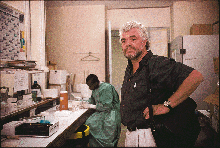
PROFILE:
Preventing Infections With Today's Tools
Jon Cohen*
Photos by Malcolm Linton
With no vaccine in sight powerful enough to halt the spread of HIV, Africa is left with one strategy to combat the epidemic: prevention. But the record of most countries on this front is dismal. The University of Manitoba's Frank Plummer, who oversees a large research collaboration in Nairobi, Kenya, says his group has identified a half-dozen effective interventions--from bottle feeding to targeting heavily infected groups to male circumcision--to lower HIV transmission rates, but "the scale at which they're implemented is tiny."
"We know how to prevent this infection by targeting behaviors and individuals who are at risk," says Plummer, a specialist in sexually transmitted diseases (STDs) whose team's pioneering studies have focused on sex workers, long-distance truck drivers, adolescents, and babies of infected mothers. "It's been shown to work in Thailand and by our group here. ... [The measures] need to be implemented as quickly as possible."
The collaboration's work with Nairobi prostitutes indicates the powerful multiplier effect of interventions aimed at "core groups" that infect many people. A study of more than 1000 sex workers published in the April 1991 issue of the journal AIDS by Plummer, the University of Nairobi's Elizabeth Ngugi and Jeckoniah Ndinya-Achola, and co-workers estimates that their interventions--such as peer-group education, HIV testing and counseling (with distribution of condoms), and treatment of STDs--prevented between 6000 and 10,000 new HIV infections per year among customers and their contacts. The researchers calculated that it only costs between $8 and $12 to prevent each infection. "We need to work with vulnerable groups like sex workers in a very humane way so we can reach people in that population whom they're infecting," says Ngugi, the main liaison with these women. "They are husbands. They are sons. Their sons have wives. High school kids tell me they go for 'breakfast' to sex workers."
The Kenyan group also has produced evidence that male circumcision may lower the risk of HIV infection. In 1994, Stephen Moses, Allan Ronald, Plummer, and co-workers published a sweeping review of 30 epidemiologic studies showing a strong correlation between high rates of HIV infection in Africa and populations that don't practice male circumcision. "If I had my way, there would be circumcision offered to all adult men in AIDS-endemic areas, plus newborn circumcision," says Plummer, who nevertheless recognizes the tricky medical and cultural issues.

Application denied. Frank Plummer sees several underused strategies to thwart the spread of HIV.
Although the Kenyan group and several others have shown a strong correlation between having an STD and the risk of being infected with HIV, two large studies in Africa have come to different conclusions on whether widespread STD treatments would cut HIV transmission rates. One study published in 1995 followed 8500 people in Mwanza, Tanzania, half of whom took part in an intensified STD care and treatment program, while the others received the standard care in the region. At the end of 2 years, there were 40% fewer HIV infections among the treatment group. Then last year, researchers working in Rakai, Uganda, surprisingly reported that their trial, which was nearly twice as large, found no connection between STD treatment and HIV infection rates.
AIDS researchers are passionately debating whether differences in overall HIV prevalences between the two cities--4% in Mwanza and 16% in Rakai--or differences in STD treatment strategies could explain the contradictory results. But in any case, researchers emphasize that it makes sense to treat STDs. As a commentary in The Lancet--which published both reports--noted when the Rakai paper appeared, "anything short of an immediate response and a sustained commitment to STD prevention and control programmes is unthinkable."
Although Plummer can point to successes in Kenya applying his group's research results, he says that for the most part, prevention efforts have few powerful advocates. "Prevention isn't at the top of the research agenda," says Plummer. He then quotes Allan Ronald, the Canadian who started the Nairobi collaboration: "One hundred years from now, they'll say, 'They certainly underestimated this and put far too little into it far too late.' "
* Jon Cohen was accompanied by photographer Malcolm Linton. For a gallery of additional photos and the stories behind them, see
www.sciencemag.org/feature/data/aids_africa/gallery.shl.
Volume 288,
Number 5474,
Issue of 23 Jun 2000,
p. 2161.
Copyright © 2000 by The American Association for the Advancement of Science.
|